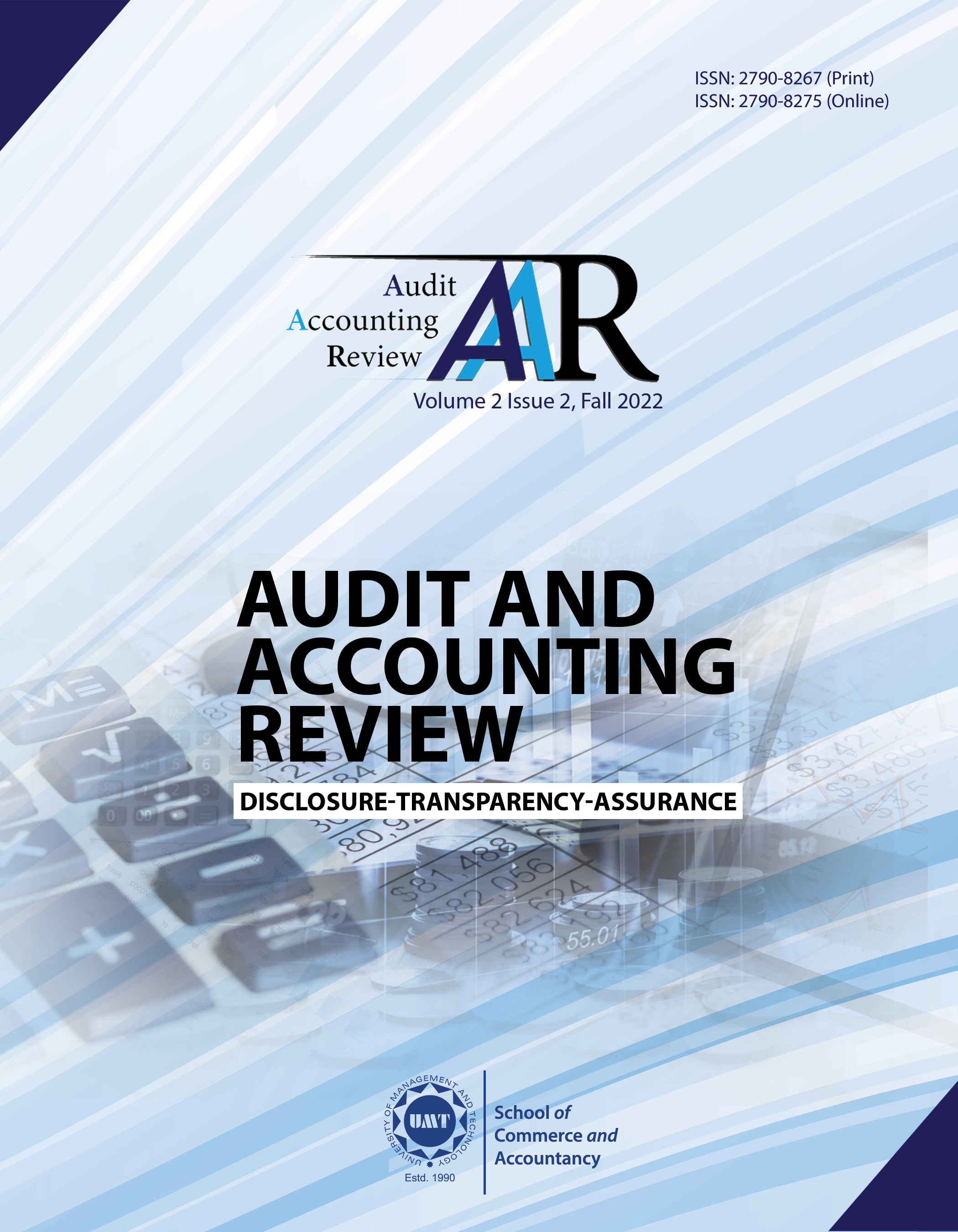Nexus between Investor Sentiment and Equity Returns in Pakistan Stock Exchange
Abstract
 Abstract Views: 60
Abstract Views: 60
The term Investor Sentiment (IS) depicts the mental activities of investors and reflects their expectations towards the market. It plays a crucial role in their decision making process, which ultimately affects the stock market. The current research attempted to examine the nexus between IS and Equity Returns (ER) of 61 financial and non-financial firms of the KSE-100 index of Pakistan Stock Exchange (PSX). Data was collected from the official website of PSX and the published annual reports of the companies for the period 2008–2019. Vector Auto Regression Model (VAR) was used to determine the relationship between dependent and independent variables. The findings revealed that the Share Turnover (SHT) and Money Flow Index (MFI) indicated a significant positive relationship with ER for the KSE-100 index. Similarly, the Price Earnings Ratio (PER) was found to be significantly inversely related to ER. The current study is important both for investors to predict stock trends and for the government's formulation of policies to prevent excessive stock market volatility. It also suggests some important implications for policymakers and investors in order to improve investment policies and make good investment decisions.
Keywords: Investor Sentiment, price earnings ratio, share turnover, money flow index.
JEL Codes: E41, E43, E42, E31
Downloads
References
Aggarwal, D., & Mohanty, P. (2018). Do Indian stock market sentiments impact contemporaneous returns? South Asian Journal of Business Studies, 7(3), 332–346. https://doi.org/10.1108/SAJBS-06-2018-0064
Alrabadi, D. W. H. (2015). A new proxy for investor sentiment: evidence from an emerging market. Afro-Asian Journal of Finance and Accounting, 5(4), 334–343. https://doi.org/10.1504/AAJFA.2015.073471.
Anderson, K., & Brooks, C. (2006). The long‐term price‐earnings ratio. Journal of Business Finance & Accounting, 33(7‐8), 1063–1086. https://doi.org/10.1111/j.1468-5957.2006.00621.x
Antoniou, C., Doukas, J. A., & Subrahmanyam, A. (2015). Investor sentiment, beta, and the cost of equity capital. Management Science, 62(2), 347–367. https://doi.org/10.1287/mnsc.2014.2101
Baker, M., & Stein, J. C. (2004). Market liquidity as a sentiment indicator. Journal of Financial Markets, 7(3), 271–299. https://doi.org/10.1016/j.finmar.2003.11.005
Baker, M., & Wurgler, J. (2006). Investor sentiment and the cross‐section of stock returns. The Journal of Finance, 61(4), 1645–1680. https://doi.org/10.1111/j.1540-6261.2006.00885.x
Baker, M., & Wurgler, J. (2007). Investor sentiment in the stock market. Journal of Economic Perspectives, 21(2), 129–152. https://www.aeaweb.org/articles?id=10.1257/jep.21.2.129.
Barberis, N., Shleifer, A., & Vishny, R. (1998). A model of investor sentiment. Journal of Financial Economics, 49(3), 307–343. https://doi.org/10.1016/S0304-405X(98)00027-0
Bernard, V. L., & Thomas, J. K. (1990). Evidence that stock prices do not fully reflect the implications of current earnings for future earnings. Journal of Accounting and Economics, 13(4), 305–340. https://doi.org/10.1016/0165-4101(90)90008-R
Braun, P. A., & Mittnik, S. (1993). Misspecifications in vector autoregressions and their effects on impulse responses and variance decompositions. Journal of Econometrics, 59(3), 319–341. https://doi.org/10.1016/0304-4076(93)90029-5
Brown, G. W., & Cliff, M. T. (2004). Investor sentiment and the near-term stock market. Journal of Empirical Finance, 11(1), 1–27. https://doi.org/10.1016/j.jempfin.2002.12.001
Brown, G. W., & Cliff, M. T. (2005). Investor sentiment and asset valuation. The Journal of Business, 78(2), 405–440. https://doi.org/10.1086/427633.
Bryman, A., & Bell, E. (2007). Business research methods. Oxford University Press.
Cavanaugh, J. E., & Neath, A. A. (2019). The Akaike information criterion: Background, derivation, properties, application, interpretation, and refinements. Wiley Interdisciplinary Reviews: Computational Statistics, 11(3), 1–12. https://doi.org/10.1002/wics.1460
Chakraborty, M., & Subramaniam, S. (2020). Asymmetric relationship of investor sentiment with stock return and volatility: Evidence from India. Review of Behavioral Finance, 12(4), 435–454. https://doi.org/10.1108/RBF-07-2019-0094
Chen, H., Chong, T. T.-L., & Duan, X. (2010). A principal-component approach to measuring investor sentiment. Quantitative Finance, 10(4), 339–347. https://doi.org/10.1080/14697680903193389
Chi, L., Zhuang, X., & Song, D. (2012). Investor sentiment in the Chinese stock market: An empirical analysis. Applied Economics Letters, 19(4), 345–348. https://doi.org/10.1080/13504851.2011.577003
Chong, T. T.-L., Cao, B., & Wong, W. K. (2017). A principal component approach to measuring investor sentiment in Hong Kong. MPRA. https://mpra.ub.uni-muenchen.de/id/eprint/77147
Concetto, C. L., & Ravazzolo, F. (2019). Optimism in financial markets: Stock market returns and investor sentiments. Journal of Risk and Financial Management, 12(2), 1–14. https://doi.org/10.3390/jrfm12020085
Corredor, P., Ferrer, E., & Santamaria, R. (2015). The impact of investor sentiment on stock returns in emerging markets: The case of Central European Markets. Eastern European Economics, 53(4), 328–355. https://doi.org/10.1080/00128775.2015.1079139
Dalika, N. K., & Seetharam, Y. (2014). Sentiment and returns: Analysis of investor sentiment in the South African market. Investment Management and Financial Innovations, 12(1), 267-276.
Dash, S. R., & Maitra, D. (2018). Does sentiment matter for stock returns? Evidence from Indian stock market using wavelet approach. Finance Research Letters, 26, 32–39. https://doi.org/10.1016/j.frl.2017.11.008
Dickey, D. A., & Fuller, W. A. (1979). Distribution of the estimators for autoregressive time series with a unit root. Journal of the American Statistical Association, 74(366a), 427–431. https://doi.org/10.1080/01621459.1979.10482531
Finter, P., Niessen-Ruenzi, A., & Ruenzi, S. (2012). The impact of investor sentiment on the German stock market. Zeitschrift für Betriebswirtschaft, 82(2), 133–163. https://doi.org/10.1007/s11573-011-0536-x.
Fisher, K. L., & Statman, M. (2006). Market timing in regressions and reality. Journal of Financial Research, 29(3), 293–304. https://doi.org/10.1111/j.1475-6803.2006.00179.x.
Frost, J. (2014). How to interpret regression models that have significant variables but a low R-squared. Statistics by Jim. https://statisticsbyjim.com/regression/low-r-squared-regression/
Frugier, A. (2016). Returns, volatility and investor sentiment: Evidence from European stock markets. Research in International Business and Finance, 38, 45–55. https://doi.org/10.1016/j.ribaf.2016.03.007
Granger, C. W. (1969). Investigating causal relations by econometric models and cross-spectral methods. Econometrica: Journal of the Econometric Society, 37(3), 424–438. https://doi.org/10.2307/1912791.
Grigaliūnienė, Ž., & Cibulskienė, D. (2010). Investor sentiment effect on stock returns in Scandinavian stock market. Economics and Management, 15, 929-940.
Hair, J. F., Black, W. C., Babin, B. J., Anderson, R. E., & Tatham, R. L. (2006). Multivariate data analysis (Vol. 6). Pearson Prentice Hall.
Hair, J. F., Hult, G. T. M., Ringle, C., & Sarstedt, M. (2016). A primer on partial least squares structural equation modeling (PLS-SEM). Sage Publications.
Huang, D., Jiang, F., Tu, J., & Zhou, G. (2015). Investor sentiment aligned: A powerful predictor of stock returns. The Review of Financial Studies, 28(3), 791–837. https://doi.org/10.1093/rfs/hhu080
Jiang, S., & Jin, X. (2021). Effects of investor sentiment on stock return volatility: A spatio-temporal dynamic panel model. Economic Modelling, 97, 298–306. https://doi.org/10.1016/j.econmod.2020.04.002
Kapoor, S., & Prosad, J. M. (2017). Behavioural finance: A review. Procedia Computer Science, 122, 50–54. https://doi.org/10.1016/j.procs.2017.11.340
Kim, K. A., & Nofsinger, J. R. (2008). Behavioral finance in Asia. Pacific-Basin Finance Journal, 16(1-2), 1–7. https://doi.org/10.1016/j.pacfin.2007.04.001
Kim, M., & Park, J. (2015). Individual investor sentiment and stock returns: Evidence from the Korean stock market. Emerging Markets Finance and Trade, 51(5), 1–20. https://doi.org/10.1080/1540496X.2015.1062305
Lee, P. E. (2019). The empirical study of investor sentiment on stock return prediction. International Journal of Economics and Financial Issues, 9(2), 119–124.
Liew, V. K.-S. (2004). Which lag length selection criteria should we employ? Economics Bulletin, 3(33), 1–9.
Maitra, D., & Dash, S. R. (2017). Sentiment and stock market volatility revisited: A time–frequency domain approach. Journal of Behavioral and Experimental Finance, 15, 74–91. https://doi.org/10.1016/j.jbef.2017.07.009
Markowitz, H. (1952). Portfolio selection. The Journal of Finance, 7(1), 77–91. https://doi.org/10.1111/j.1540-6261.1952.tb01525.x.
McGurk, Z., Nowak, A., & Hall, J. C. (2020). Stock returns and investor sentiment: Textual analysis and social media. Journal of Economics and Finance, 44(3), 458–485. https://doi.org/10.1007/s12197-019-09494-4.
Muguto, H. T., Muguto, L., Bhayat, A., Ncalane, H., Jack, K. J., Abdullah, S., Nkosi, T. S., & Muzindutsi, P. F. (2022). The impact of investor sentiment on sectoral returns and volatility: Evidence from the Johannesburg stock exchange. Cogent Economics & Finance, 10(1), 1–24. https://doi.org/10.1080/23322039.2019.1600233
Qiu, L., & Welch, I. (2006). Investor sentiment measures (No. w10794). National Bureau of Economic Research. https://www.nber.org/papers/w10794
Raza, S. A., Mansoor, M., & Iraqi, K. M. (2019). Influence of investor sentiments on stock market capitalization of different economic sectors in a developing economy: Evidence from Pakistan. Journal of Finance and Economics Research, 4(1), 31–43. https://doi.org/10.20547/jfer1904103.
Ryu, D., Kim, H., & Yang, H. (2017). Investor sentiment, trading behavior and stock returns. Applied Economics Letters, 24(12), 826–830. https://doi.org/10.1080/13504851.2016.1231890
Schmeling, M. (2009). Investor sentiment and stock returns: Some international evidence. Journal of Empirical Finance, 16(3), 394–408. https://doi.org/10.1016/j.jempfin.2009.01.002
Sekaran, U., & Bougie, R. (2003). Research methods for business: A skill building approach. John Willey & Sons.
Shefrin, H., & Statman, M. (2000). Behavioral portfolio theory. Journal of Financial and Quantitative Analysis, 35(2), 127–151. https://doi.org/10.2307/2676187.
Sheikh, M. F., & Riaz, K. (2012). Overconfidence bias, trading volume and returns volatility: Evidence from Pakistan. World Applied Science Journal, 18(12), 1737–1748.
Shleifer, A. (2000). Inefficient markets: An introduction to behavioural finance: OUP Oxford.
Shleifer, A., DeLong, J. B., Summers, L., & Waldmann, R. (1990). Noise trader risk in financial markets. Journal of Political Economy, 98(4), 703–738.
Shleifer, A., & Summers, L. H. (1990). The noise trader approach to finance. Journal of Economic Perspectives, 4(2), 19–33. https://doi.org/10.1257/jep.4.2.19.
Sinha, N. R. (2016). Underreaction to news in the US stock market. Quarterly Journal of Finance, 6(2), 1–48. https://doi.org/10.1142/S2010139216500051
Statman, M., Thorley, S., & Vorkink, K. (2006). Investor overconfidence and trading volume. The Review of Financial Studies, 19(4), 1531–1565. https://doi.org/10.1093/rfs/hhj032
Thornhill, A., Saunders, M., & Lewis, P. (2009). Research methods for business students: Prentice Hall.
Van Blerkom, M. L. (2017). Measurement and statistics for teachers. Taylor & Francis.
Wang, W., Su, C., & Duxbury, D. (2021). Investor sentiment and stock returns: Global evidence. Journal of Empirical Finance, 63, 365–391. https://doi.org/10.1016/j.jempfin.2021.07.010
Yates, J. F., Lee, J.-W., & Bush, J. G. (1997). General knowledge overconfidence: cross-national variations, response style, and “reality”. Organizational Behavior and Human Decision Processes, 70(2), 87–94. https://doi.org/10.1006/obhd.1997.2696
Copyright (c) 2022 Shiza Khan, Faiza Saleem

This work is licensed under a Creative Commons Attribution 4.0 International License.
Authors retain copyright and grant the journal right of first publication with the work simultaneously licensed under a Creative Commons Attribution (CC-BY) 4.0 License that allows others to share the work with an acknowledgement of the work’s authorship and initial publication in this journal.







